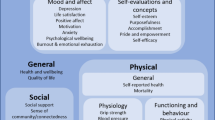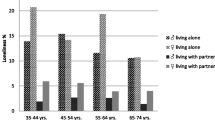“[T]he generous will prosper, and those who refresh others will themselves be refreshed.” (Proverbs, 11:25).
Abstract
Little is known about the health impact of helping behaviors among individuals with high-risk chronic diseases such as cardiovascular disease (CVD). Using a nationally representative, longitudinal survey, we examined the subsequent health of adults with CVD (n = 4,491) who spent time providing non-paid assistance to family and friends outside of their households compared with those who had provided no assistance. After both adjusting for baseline characteristics and using propensity score matching methods, spending up to 200 h over the prior 12 months helping others was associated with lower odds of experiencing a new CVD event or dying in the subsequent 2 years. Providing up to 100 h of assistance was associated with reporting fewer depressive symptoms. This threshold effect raises the question of whether assistance beyond a certain number of hours may impose a burden that mitigates health benefits from helping others. Health care providers could play an important role exploring ways that patients with CVD can provide beneficial levels of assistance to others in their own social networks or communities, thereby possibly also improving their own health.


Similar content being viewed by others
References
Baumeister, R. (1991). Meanings of life. New York, New York: Gilford Press.
Berkman, L. F., & Glass, T. (2000). Social integration, social networks, social support, and health. In L. F. Berkman & I. Kawachi (Eds.), Social epidemiology. New York: Oxford.
Berkman, L. F., et al. (2003). Effects of treating depression and low perceived social support on clinical events after myocardial infarction: The enhancing recovery in coronary heart disease patients (ENRICHD) randomized trial. JAMA, 289, 3106–3116.
Brown, S. L., et al. (2012). Caregiving and decreased mortality risk. Psychological Science, In Press
Brown, S. L., & Brown, R. M. (2006). Selective investment theory: Recasting the functional significance of close relationships. Psychological Inquiry, 17, 1–29.
Brown, S. L., et al. (2003). Providing social support may be more beneficial than receiving it: Results from a prospective study of mortality. Psychological Science, 14, 320–327.
Brown, W. M., et al. (2005). Altruism relates to health in an ethnically diverse sample of older adults. Journals of Gerontology. Series B, Psychological Sciences and Social Sciences, 60B, 143–152.
Brown, S. L., et al. (2008). Self-reported helping behavior predicts coping with spousal loss. Personality and Social Psychology Bulletin, 34, 849–861.
Brunstein, J. C. (1993). Personal goals and subjective well-being: A longitudinal study. Journal of Personality and Social Psychology, 65, 1061–1070.
Carlin, J. B., et al. (2008). A new framework for managing and analyzing multiply imputed data in Stata. The Stata Journal, 8, 49–67.
Carter, C. S. (1998). Neuroendocrine perspectives on social attachment and love. Psychoneuroendocrinology, 23, 779–818.
Cialdini, R. B., et al. (1997). Reinterpreting the empathy-altruism relationship: When one into one equals oneness. Journal of Personality and Social Psychology, 73, 481–494.
DiMatteo, M. R. (2004). Social support and patient adherence to medical treatment: A meta-analysis. Health Psychology, 23, 207–218.
Estabrooks, P. A., et al. (2003). Physical activity promotion through primary care. JAMA, 289, 2913–2916.
Friedmann, E. et al. (2006). Relationship of depression, anxiety, and social isolation to chronic heart failure outpatient mortality. American Heart Journal, 152(5), 940 e941–940 e948
Gallant, M. P. (2003). The influence of social support on chronic illness self-management: a review and directions for research. Health Education & Behavior, 30, 170–195.
Heaphy, E. D., & Dutton, J. E. (2008). Positive social interactions and the human body at work: Linking organizations and physiology. Academy of Management Review, 33, 137–162.
Hirschfelder, A. S., & Reilly, S. L. (2007). Rx: Volunteer: A prescription for healthy aging. In S. Post (Ed.), Altruism and health (pp. 115–140). New York: Oxford University Press.
House, J. S. (2001). Social isolation kills, but how and why? Psychosomatic Medicine, 63, 273–274.
House, J. S., et al. (1988). Social relationships and health. Science, 241, 540–545.
Idler, E. L., & Benyamini, Y. (1997). Self-rated health and mortality: A review of twenty-seven community studies. Journal of Health and Social Behavior, 38, 21–37.
Ironson, G., & Hayward, H. (2008). Do positive psychosocial factors predict disease progression in HIV-1? A review of the evidence. Psychosomatic Medicine, 70, 546–554.
Juster, F. T., & Suzman, R. (1995). An overview of the health retirement study. J Human Research, 30, S7–S56.
Krause, N., et al. (1992). Providing support to others and well-being in later life. Journal of Gerontology, 47, 300–311.
Krumholz, H. M., et al. (1998). Prognostic importance of emotional support for elderly patients hospitalized with heart failure. Circulation, 97, 958–964.
Liang, J., et al. (2001). Social exchange and well-being: Is giving better than receiving? Psychology and Aging, 16, 511–523.
Lloyd, C., et al. (2005). Stress and diabetes: A review of the links. Diabetes Spectrum, 18, 121–127.
Luoh, M. C., & Herzog, A. R. (2002). Individual consequences of volunteer and paid work in old age: Health and mortality. Journal of Health and Social Behavior, 43, 490–509.
Luttik, M. L., et al. (2005). The importance and impact of social support on outcomes in patients with heart failure: An overview of the literature. Journal of Cardiovascular Nursing, 20, 162–169.
McEwen, B. S. (1998). Protective and damaging effects of stress mediators. New England Journal of Medicine, 338, 171–179.
Moran, A., et al. (2008). Social support and conscientiousness in hemodialysis adherence. Annals of Behavioral Medicine, 19, 333–338.
Murberg, T. A. (2004). Long-term effect of social relationships on mortality in patients with congestive heart failure. International Journal of Psychiatry in Medicine, 34, 207–217.
Musick, M. A., & Wilson, J. (2003). Volunteering and depression: The role of psychological and social resources in different age groups. Social Science and Medicine, 56, 259–269.
Oman, D. (2007). Does volunteering foster physical health and longevity? In S. Post (Ed.), Altruism and health (pp. 15–32). New York: Oxford University Press.
Post, S. G. (2005). Altuism, happiness, and health: It’s good to be good. International Journal of Behavioural Medicine, 12, 66–77.
Post, S. (2007). Altruism and health. New York: Oxford University Press.
Radloff, L. S. (1977). The CES-D scale: A self-report depression scale for research in well older adults. Applied Psychological Measurement, 1, 385–401.
Sayers, S. L., et al. (2008). Social support and self-care of patients with heart failure. Annals of Behavioral Medicine, 35, 70–79.
Schwartz, C. E., & Sendor, M. (1999). Helping others helps oneself: Response shift effects in peer support. Social Science and Medicine, 48, 1563–1575.
Schwartz, C., & Sendor, M. (2000). Helping others helps oneself: Response shift effects in peer support. In K. Schmaling (Ed.), Adaptation to changing health: Response shift in quality-of-life research. Washington, DC: American Psychological Association.
Schwartz, C. E., et al. (2003). Altruistic social interest behaviors are associated with better mental health. Psychosomatic Medicine, 65, 778–785.
Schwartz, C. E., et al. (2004). Exploring response shift in longitudinal data. Psychology & Health, 19, 51–69.
Smith, C., et al. (1994). Meta-analysis of the associations between social support and health outcomes. Annals of Behavioral Medicine, 16, 352–362.
Soldo, B. J. et al. (1997). Asset and health dynamics among the oldest old: An overview of the AHEAD study. Journals of Gerontology Series B: Psychological Sciences and Social Sciences, 52 Spec No, 1–20
Steffick, D., & Group, H. R. S. H. W. (2000). Documentation of affective functioning measures in the health and retirement study. Ann Arbor: Survey Research Center, University of Michigan.
Surwit, R. S., et al. (2002). Stress management improves long-term glycemic control in type 2 diabetes. Diabetes Care, 25, 30–34.
Van Willigen, M. (2000). Differential benefits of volunteering across the life course. Journals of Gerontology. Series B, Psychological Sciences and Social Sciences, 55, S308–S318.
Wheeler, J. A., et al. (1998). The beneficial effects of volunteering for older volunteers and the people they serve: A meta-analysis. International Journal of Aging and Human Development, 47, 69–79.
Wiesli, P., et al. (2005). Acute psychological stress affects glucose concentrations in patients with type 1 diabetes following food intake but not in the fasting state. Diabetes Care, 28, 1910–1915.
Yinon, Y., & Landau, M. O. (1987). On the reinforcing value of helping behavior in a positive mood. Motivation and Emotion, 11, 83–93.
Zhang, X., et al. (2007). Social support and mortality among older persons with diabetes. Diabetes Education, 33, 273–281.
Acknowledgments
This study was supported by the Michigan Institute for Clinical and Health Research (NIH #UL1RR024986).
Author information
Authors and Affiliations
Corresponding author
Appendix
Appendix
Propensity Score Matching (PSM) Methods
We implemented propensity score matching method in selecting respondents with CVD who have similar propensity of helping non-coresident friends and relatives over the prior 12 months in order to address a reviewer’s concern and suggestions corresponding to an earlier version of the study manuscript:
.. it’s also likely that such healthy people are more likely to take on the task of helping others. The longitudinal analysis seems to control for as many of these things as possible, but (as the authors acknowledge) there are likely unaccounted for correlates of these things (e.g., adherence to medication, adherence to other medical recommendations, access to quality health care, blood pressure, etc.) that it is not possible to account for because they were not measured. Normally controlling for covariates is sufficient, but in this case the differences between the helper and non-helper groups at baseline are so dramatic, it doesn’t lead to a very compelling case. I’m unsure what the best way would be to attempt to parse this out, but given the large sample size, there may be ways to provide more compelling evidence for the health benefits of helping others. One possibility would be to attempt a matched control design or sub-analyses within socio-economic status (SES) categories. As it stands, the data suggest that healthier, happier, better educated, and more affluent people are more likely to help others and retain their health later (relative to less healthy, happy, educated, and affluent people).
Using all baseline covariates (gender, age, race, education, poverty ratio, living arrangement in 2002, comorbidity, self-rated-health status, activities of daily living (ADLs), instrumental activities of daily living (IADLs), depressive symptoms (CESD score), smoking, physical activity and drinking behavior in 2002), we obtained propensity scores of providing assistance to non-coresident friends, neighbors and relatives over the prior 12 months in the 2002 survey. Figure 3 below plots a kernel density estimate for propensity scores by helping status in 2002. Kernel density estimation is a non-parametric way of estimating the probability density function of a variable, which approximates the density from observations similar to histograms. A detailed description on kernel density estimation employed in this paper can be found elsewhere (STATA 12 reference manual: kdensity, twoway kdensity).
We then implemented one-to-one match based on the nearest neighbor match. Out of 4,490 respondents, we have 1,352 respondents matched (676 not helped in 2002 and 676 helped in 2002). Figure 4 shows the kernel density of propensity score after match.
Rights and permissions
About this article
Cite this article
Heisler, M., Choi, H., Piette, J.D. et al. Adults with cardiovascular disease who help others: a prospective study of health outcomes. J Behav Med 36, 199–211 (2013). https://doi.org/10.1007/s10865-012-9414-4
Received:
Accepted:
Published:
Issue Date:
DOI: https://doi.org/10.1007/s10865-012-9414-4






